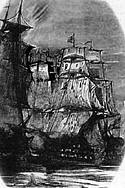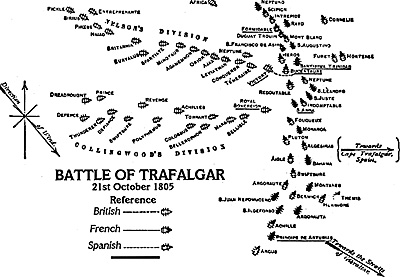The Redoutable was a French 74 gun third rate ship of the line and launched from the building slip at Lorient in 1792. Originally it was given the name Bailli de Suffren, after the great French Admiral. Due to the crew's inistance that the name be altered to Redoutable - such things were possible during the confusion of the revolution - it was changed shortly after the launch.
In 1794 the Brest squadron was ordered out, although under blockade. Only Redoutable and Republicain were able to put to sea only to encounter a storm that destroyed Republicain. Redoutable was able to make sail and made for safety.
Redoutable continued to hit storms for the remainder of the year and a junction with supporting ships during a violent storm concluded the year with four more ships destroyed.
Rescue
In February 1795 the remaining ships who had conquered the storm returned to the port of Brest. In June the Redoutable accompanied by eight others went on a rescue mission to free three other vessels blockaded by British ships at Belle Isle. The mission was accomplished but at the loss of three ships! Whilst many other senior officers were court-martialled following this action the commander of the Redoutable, Captain Moncousu recieved praise for his brave conduct.
Following this battle Redoutable returned to Lorient where she acted as a reserve vessel until the winter of 1796 when she joined an expedition to Ireland that again ended in disaster amid awful storms. On returning to port, Redoutable was refitted.
Redoutable's compliment consisted of 690 crew at full strength. She carried 28 x 36 pdr. guns on the main deck, 30 x 24 pdr. guns on the 2nd deck and 12 x 8 pdr. on the quarter-deck, 4 x 8 pdrs. in the forecastle and 4 x 36 pdr. carronades on the poop deck. poop deck.
In 1799 the Redoutable commanded by Captain Maillard La Morandais again put to sea for a brief period, evading the British blockades, until the Peace of Amiens was confirmed in 1802.
Ship Alterations
An interesting arrangement occurred during this peace, when the Redoutable was stripped of one layer of guns and armed en flute. In April, accompanied by 500 soldiers, another 74 gun ship and several smaller vessels, Redoutable made for Guadeloupe, only to return to Brest by 20th August 1802. During that winter, Redoutable continued to act as a troop ship, moving troops to Saint Domingue where the army of Toussaint L'Ouverture was giving the French a hard time. Fortunately the Redoutable's crew did not catch yellow fever. Less fortunate was the land force that, initially 35,000 strong, was depleted to 9,000 by 1803.
Redoutable and the squadron commanded by Admiral Bedout now found the Brest port again blockaded and harboured instead at the Spanish port of Ferrol where the British had not yet deployed their blockading forces.
In 1804 the British navy had successfully prevented the French and Spanish ships from leaving Ferrol. So Redoutable was made ready as a ship of the line once again in preparation for Napoleon's proposed invasion of England.
The French and Spanish fleets, moored in Brest, Ferrol, Cadiz and Toulon, were becoming extremely lax and ill disciplined. The blockade prevented any opportunity to sail or train at sea or otherwise occupy the crews. Redoutable's crew was no exception until in November 1803 Captain Jean Lucas took command.
Captain Jean Lucas
Although under five feet tall, Lucas had the qualities of discipline that even Villeneuve lacked. He was an experienced officer having served on the Formidable before being given command of Hannibal - both excellent ships.
When Lucas transferred to Redoutable he found among the crew many soldiers from the expeditions to Saint Domingue. Once the guns were replaced, the crew needed to be trained and disciplined. Lucas, in the confinement of Ferrol, drilled his men not with broadside or gunnery tactics but with the musket, cutlass and grenades.
Lucas' tactics, imposed by the blockade and superior gunnery of the British, were to run alongside a ship, close the gun-ports, grapple and board. As the ships closed, musketry along with grenades would sweep the enemy's upper deck. This proved to be deadly effective, particularly in Nelson's case.
Lucas, during the days preceding the battle of Trafalgar, had shown contempt for many other ship's crews that he considered inferior to his own. Particularly their handling of their ships, something that came as second nature to his own crew. One of the most annoying instances for Lucas was when Villeneuve ordered Redoutable who was leading the van, to place herself three ahead of Bucentaure and then finally behind the French/Spanish flagship. The whole manoeuvre was achieved in the greatest disorder with sails and masts snagging and ships dropping behind.
At 11:50 am on the 21st October, Fougueux (74 guns) opened fire towards the Royal Sovereign and the order was given to engage. The whole drum and fife corps aboard Redoutable beat up enthusiastically as the musketeers presented arms and the order greeted with seven cheers of 'Vive l'Empereur'.
Redoutable had now moved three ships astern of Villeneuve's flagship, this created a gap that was not filled by the ships ordered to do so. This resulted in the Bucentaure's stern being raked by gunfire as each British ship passed through. Among these was the Victory who was out to finish the Bucentaure. Victory was intercepted by Redoutable, Lucas explains;
Redoutable vs. Victory
"Determined to sacrifice my ship for the defence of the Flagship, I explained this to my officers and crew who received my explanations with repeated shouts of "Vive l'Empereur, Vive l'Admiral, Vive le Commandant". Preceded by fifes and drums I made a tour of the gun decks; everywhere I found brave men, burning with impatience for the battle to begin; many of them called to me, "Captain, don't forget our boarding"...
Now Victory was heading straight for Redoutable and no amount of gunfire was going to deter Nelson. As Redoutable closed her lower gun-ports she crunched into the side of Victory and grappled, the crew prepared to board whilst musketry cleared the top decks. Now Victory pounded Redoutable's lower decks whose crew hurled grenades in reply. It was during this confusion that Nelson was mortally wounded when fired upon by snipers, Lucas continues;
"Just as our brave lads were about to leap after them the three decker Temeraire which had no doubt seen that the Victory fought no more and must inevitably be captured, sailed alongside us to starboard and riddled us with point blank broadsides"
Here Lucas states that the Victory was ready for capture, this is not the case considering most of the crew were firing broadsides below deck. However even if Lucas had boarded then, to gain control of the upper deck would have been incredibly difficult, even more so if Temeraire had not reinforced Victory.
Casualties aboard Redoutable were horrendous; 490 dead and 81 wounded, Lucas only struck his colours after the complete annihilation of his ship. Redoutable was originally taken as a prize but foundered during the following storm as Lucas describes;
"It was blowing hard and the sea was high, making embarkation difficult; these unfortunates, seeing that the ship was going to founder, crawled to the quarter-deck whence it was possible to save some. At 7 O'clock in the evening the Redoutable sank"....
Lucas was taken to England as a prisoner of war and was released in 1806 to the delight of the Emperor who awarded him the Legion of Honour. He was given command of the Regulus but retired in 1816 due to Minister of Marine Decres' hostile attitude towards Villeneuve's tactics - a matter that Lucas defended vigorously. (Villeneuve committed suicide because of the defeat.)
Captain Jean Lucas died on 6th November 1819.
Related Profile:
This article appears in MagWeb (Magazine Web) on the Internet World Wide Web. With most of the senior commanders guillotined during the Revolution the French Navy suffered appalling problems when facing the British navy. This was well illustrated at the battle of the 'Glorious First Of June' in 1794 where the French lost seven ships. Luckily Redoutable was not present at this battle.
With most of the senior commanders guillotined during the Revolution the French Navy suffered appalling problems when facing the British navy. This was well illustrated at the battle of the 'Glorious First Of June' in 1794 where the French lost seven ships. Luckily Redoutable was not present at this battle.
Trafalgar
 After a series of arduous sailing manoeuvres with the combined fleet, Lucas and Redoutable - the best ship in the Franco-Spanish fleet - were positioned behind Villeneuve's Bucentaure (80 guns) and in front of the Spaniard San Justo (74 guns), directly in Victory's line of approach.
After a series of arduous sailing manoeuvres with the combined fleet, Lucas and Redoutable - the best ship in the Franco-Spanish fleet - were positioned behind Villeneuve's Bucentaure (80 guns) and in front of the Spaniard San Justo (74 guns), directly in Victory's line of approach.
Capt. Lord Thomas Cochrane, "The Sea Wolf"
Back to Table of Contents -- First Empire #31
© Copyright 1996 by First Empire.
Other military history articles and gaming articles are available at http://www.magweb.com